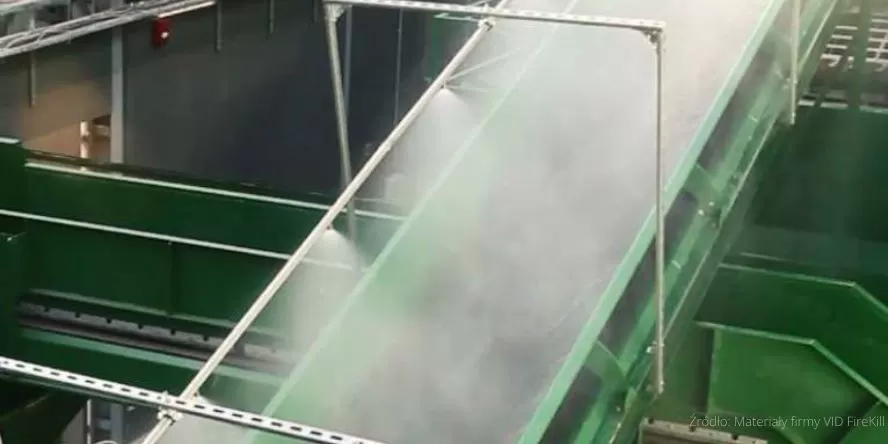Project challenges
- The switch from coal fuel to a mixture of coal with more ignitable and explosive biomass increased the risks of fire and explosion in the power
- The investor had to decide between two effective fire protection techniques to select the most suitable option for their conveyor belt.
- The decisive factors were: the weight of the system and the time needed for installation.
The solution:
- To reduce the risk of structural overload on the conveyors, a mist fire extinguisher was selected over a traditional sprinkler system.
- Unlike the nozzle system, the mist fire extinguishing system did not require a building permit.
- The mist system’s lower water usage not only prevented potential water damage and reduced the risk of flooding, but also allowed for quicker resumption of operations post-incident.
The design and installation of a fire protection system for belt conveyors was part of a large modernization project we completed for two power plants in Poland. The need to improve fire and explosion safety in these facilities resulted from changing the fuel from coal to a mixture of coal with biomass, much more easily ignitable and explosive. Apparently, the investor wanted to avoid disasters such as those that affected other plants in Poland in the past, and the Ridderskaya Test plant in Ridder, East Kazakhstan, in 2023.
However, before we were commissioned, our experts took part in a number of consultations. They were requested to recommend optimal safety systems, including extinguishing techniques for conveyor belts. The investor, a large European chemical manufacturer, considered using one of two techniques: the nozzle system or the mist fire extinguisher.
False activations of fire suppression systems are all too common industrial incidents. Losses amount from tens to hundreds of thousands of euros.
Źródło: www.tbsgmbh.com
Mist or sprinkler system: which one to choose?
Financial considerations are very often the deciding factor in the selection of the fire protection installation. In this case, the costs of both types of installations would be similar. That is why the criterion was the weight of the installation along with the extinguishing agent and its assembly time.
Mist installation consumes less water, which means that a smaller pumping station and fire-fighting water tank is needed. But in this case, there was another aspect that was crucial.
When we calculated the total weight of the nozzle system (including water), it turned out that its activation could cause the conveyors to collapse. To see the difference between the weights of both extinguishing systems, just compare the diameters of the pipes used: mist installation: DN40 pipes, nozzle system: DN100 pipes.
Water mist fire extinguishing device: lightweight, and with no paperwork
The other factor that determined the choice of a mist extinguishing device was the time needed to complete the task. This was largely dependent on the formal requirements related to the construction of the pumping station.
According to Polish construction law, a pumping station for a mist installation can be constructed without a building permit, and a nozzle installation must be cleared by the construction supervision office. This will usually postpone the completion date by 4 to 5 months.
An equally important issue was the delivery date of the pumps. In the case of the nozzle system, the waiting period was 6 months, while in the case of mist fire extinguishing devices, it was “only” 2.5 months (at the time of the construction, so the delivery dates of individual components can change).
Instead of blindly following standards when selecting a fire system, opt for expert tests. Your savings can reach several times the amount invested!
Źródło: www.tbsgmbh.com
Mist fire extinguishers: what other benefits can you expect?
Protection against flooding and downtime
The greater the amount of water used to extinguish the fire, the greater the risk of damage. This is not only about the previously discussed overload on protected machines. After the fire protection system is activated, all the water must be removed. Machinery must also be dried and inspected before production resumes. The conclusion is quite obvious then: with the same or higher extinguishing efficiency, mist fire extinguishers consume less water than nozzle installations or sprinkler systems, thus minimizing the duration of downtime.
Water curtains require less water than nozzle systems
Imagine a fire incident at your plant. The fire broke out at site A, but in addition to extinguishing it, you also want to protect the critical place B, located nearby. In this case, water curtains are usually installed to prevent flames from reaching sensitive places. By using classic nozzles for this purpose, you will use up a large amount of water, thus consuming resources that could be used for firefighting. However, water curtains created with mist nozzles will effectively protect a sensitive area while using 50 to 90% less water.
Less space and lower costs of a water tank and pumping station
The lower water consumption, which can amount to up to 90%, as well as up to 10 times greater effectiveness of mist extinguishing devices compared to classic water systems (sprinklers and nozzles) has been experimentally confirmed. This means less space is required for installing the pump and the fire water tank. This not only helps with adequate spatial planning, but also reduces investment costs.
Piping: not only smaller and lighter but also easier to install
The pipes used in fixed low pressure mist devices have a smaller diameter compared to sprinkler and nozzle systems of similar effectiveness. Their lower weight allows them to not only be mounted to devices and ceilings of halls with light or unstable construction. It also affects installation costs, especially when using snap-in connectors.
Water mist extinguishers can be just a part of a larger safety project for a power plant
As part of our cooperation with another major client, we were requested to adapt their pumping stations to current legal requirements. The trick was, however, to avoid downtime or decreased fire protection during the assembly process, as the plant is a critical infrastructure facility for a major Polish city. In the project, we not only supply an unusually large tank for the pumping station. We also took care of the entire project, from design, to assembly, down to the finishing work and documentation, see a story on our blog.






